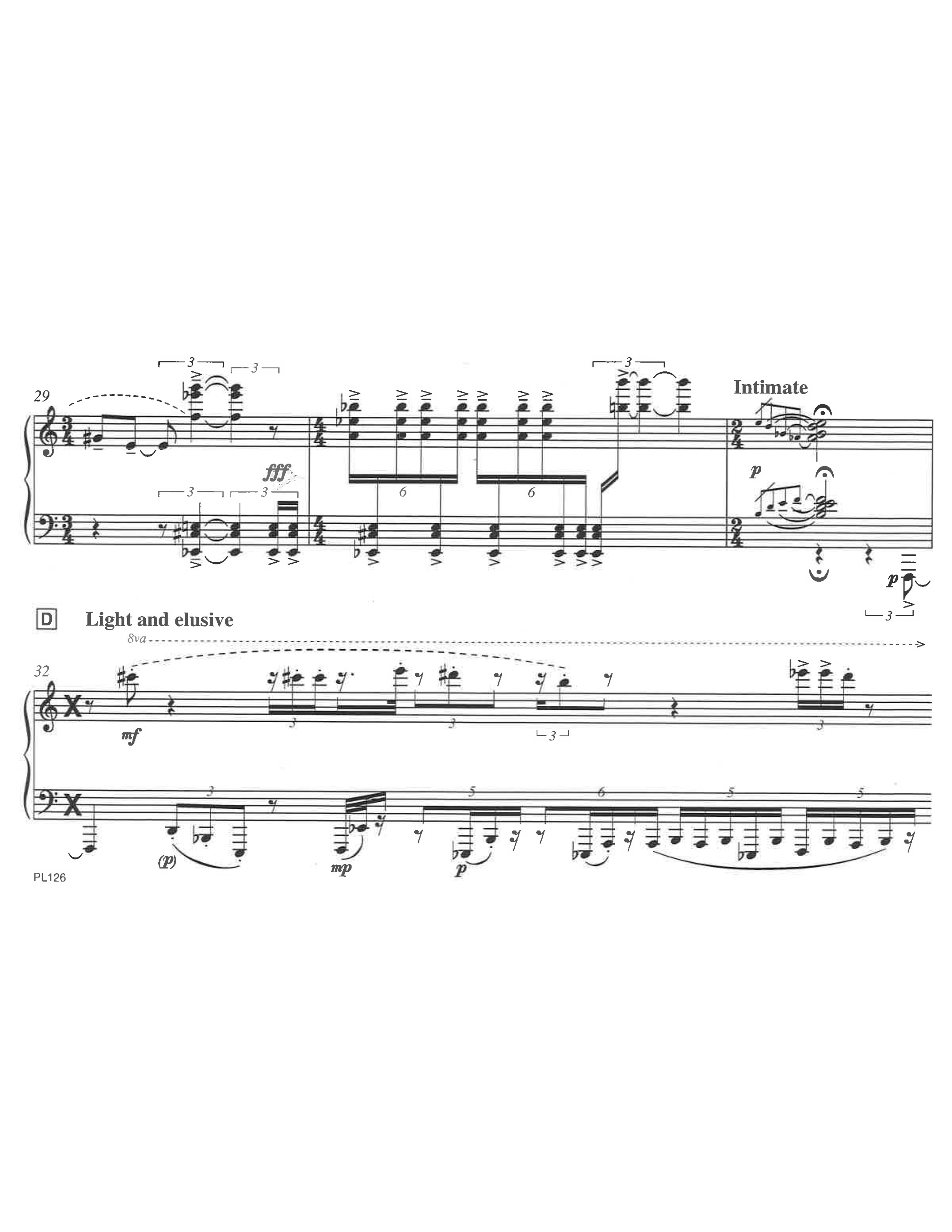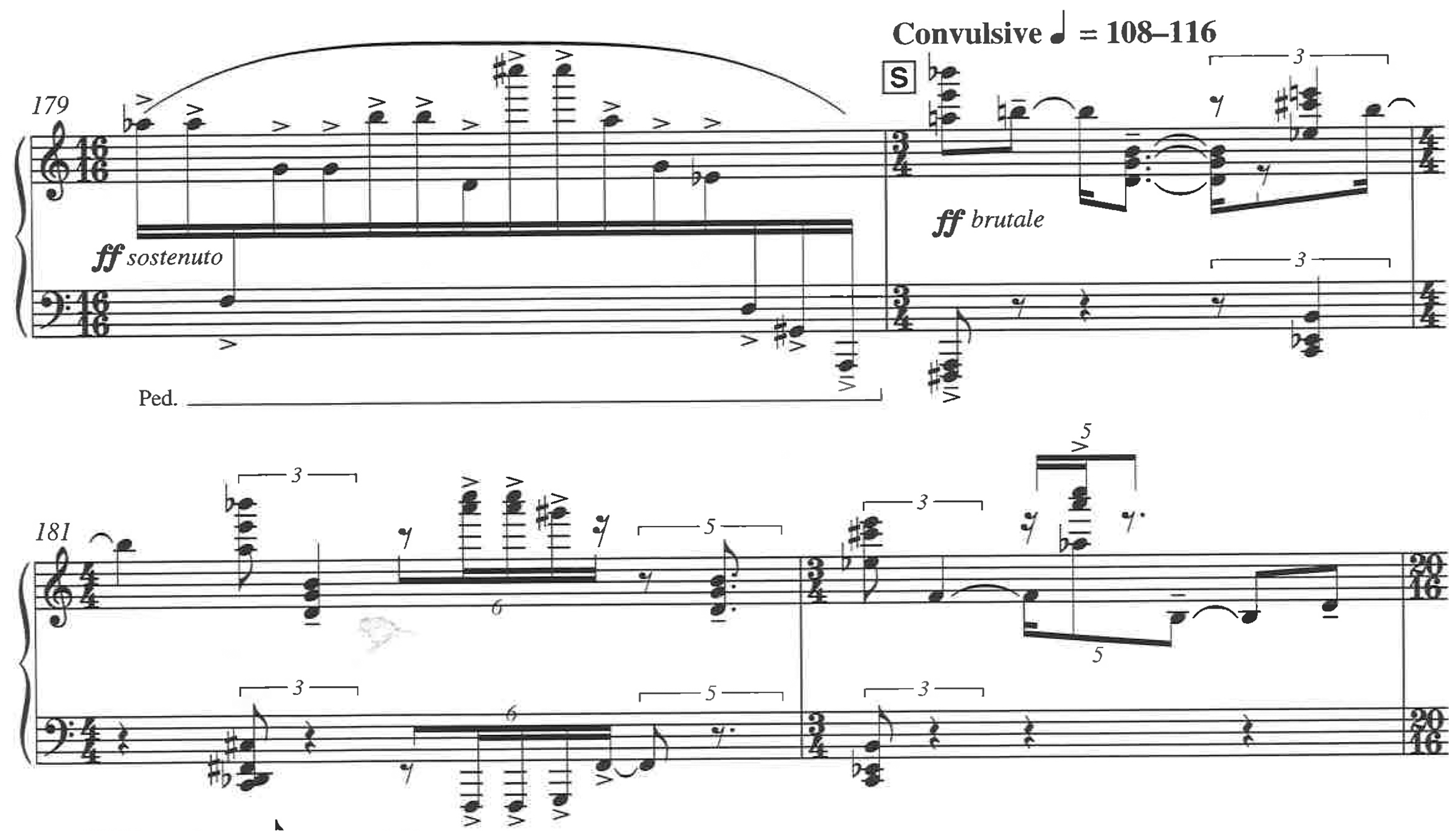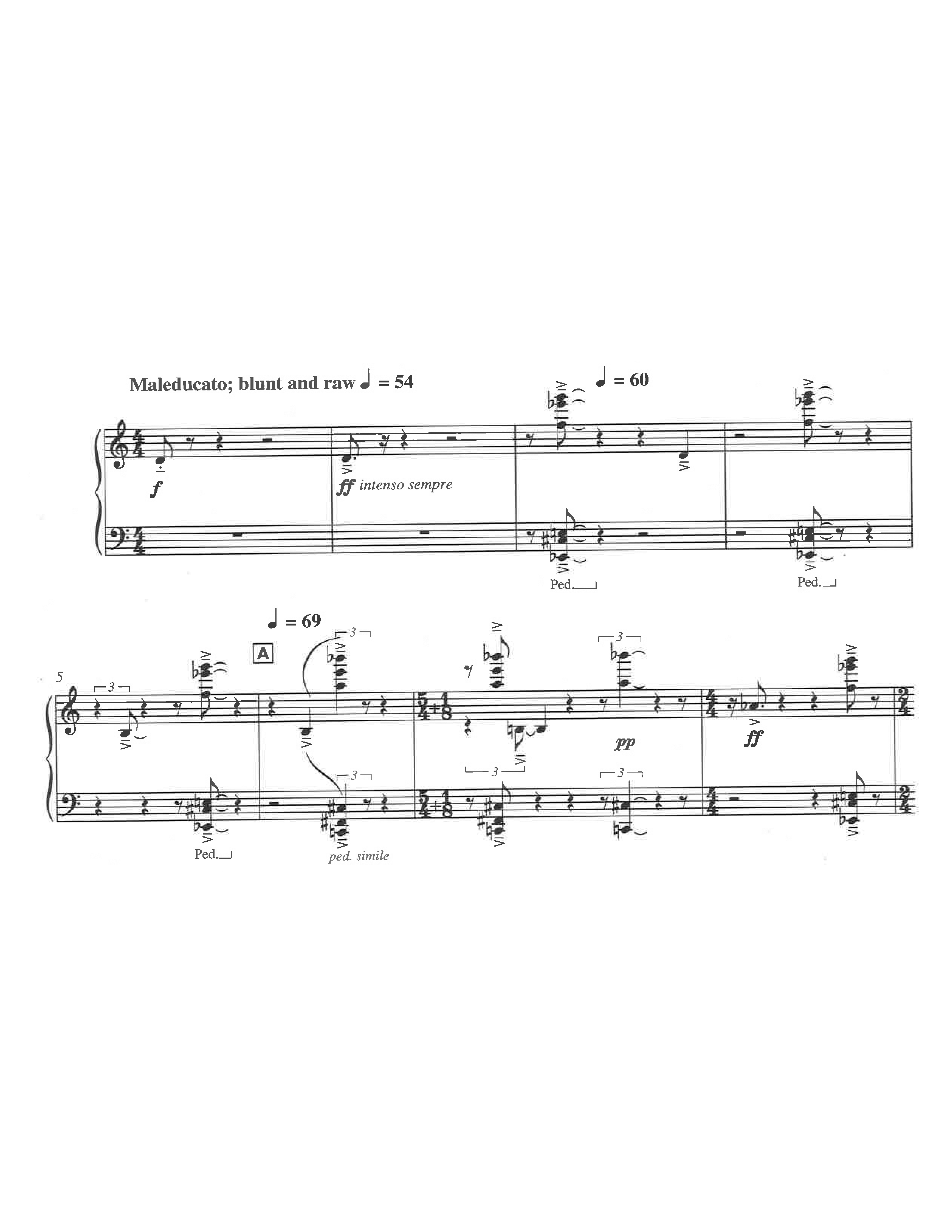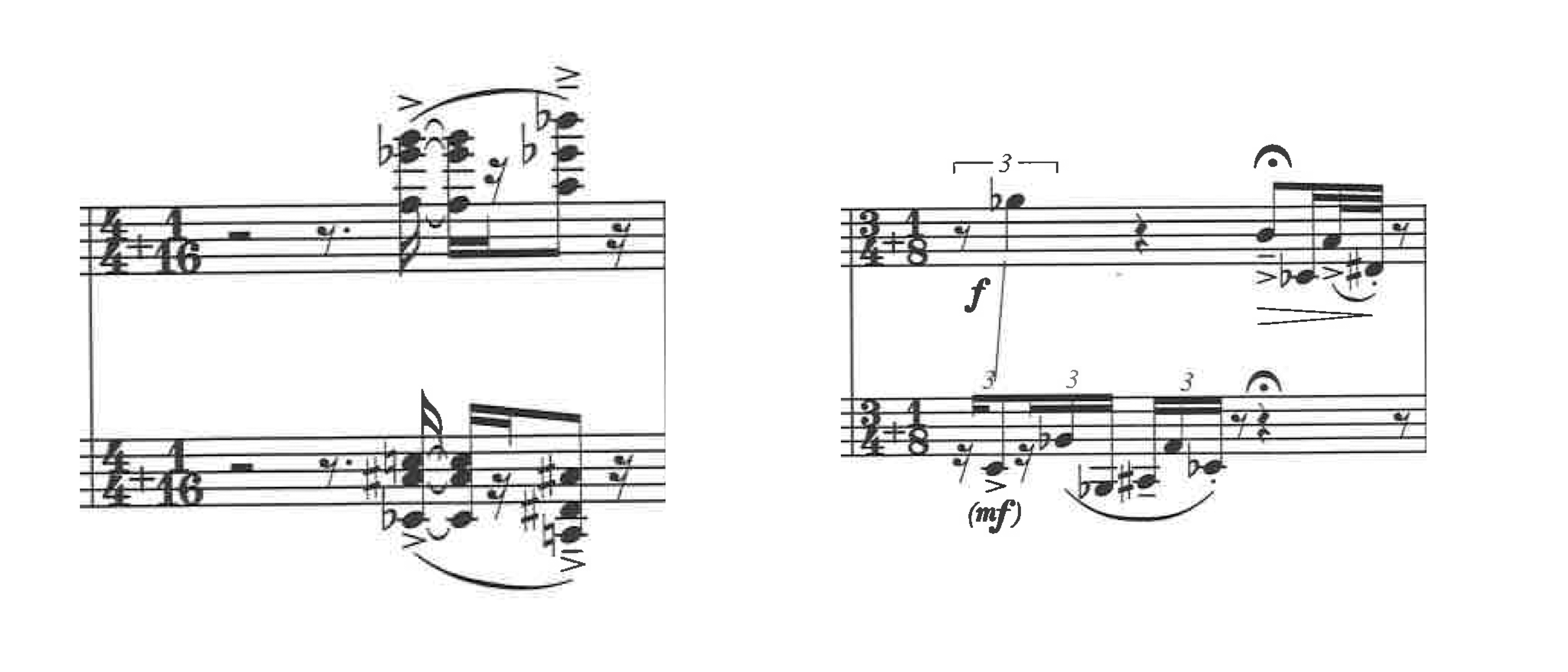It starts with a single note. “Blunt and raw,” according to the score. Poked at by the untrained brute sitting at the thing, the thing that apparently makes sound—the instrument. After a short silence, the note, the poking at the instrument, is repeated more forcefully, more insistently. And then, the first explosion, a chromatically dense block of sound spread out over four octaves. Again a poke, followed by the same explosive chord, then a different note poked at. The pokes and the explosions start to connect to each other. No discernible beat yet, no pattern, but amid all the hesitations, all the disjointed and isolated gestures, somehow, music is being born.
Truth is, I was indeed untrained, but not much of a brute. Basic Training was written by Lee Hyla at my request in honor of the piano teacher I studied with from fourth grade through high school, Margaret Saunders Ott, and jointly commissioned by the large number of musicians and music-lovers she affected over the years. Lee took the occasion as a generative idea for the substance of the piece, as he outlined in the program notes accompanying the printed score: “Basic Training loosely (and not really linearly) traces the development of a pianist from the Neanderthal-like, noise-producing thuds of first contact, through a number of textures and variations, finally achieving something of a sophisticated intimacy with the instrument.” A little context is thus in order:
I grew up in Spokane, Washington, the largest (really the only) city in the great expanse between Seattle and Minneapolis, a trade center surrounded by farms and mountains. The musical life in Spokane was all out of proportion to the size of its population and its distance from any major metropolitan center. The Spokane Symphony Orchestra had been developed from a decent amateur orchestra into a serious professional ensemble with an international roster of guest artists, giving committed, high-level performances of the major works of the orchestral repertoire, thanks to the careful, devoted and imaginative cultivation of its musical director Donald Thulean (with whom I also had the privilege of studying during my final year in Spokane). The Spokane Junior Symphony, made up of high-school age student musicians, was at the level where they could perform Charles Ives’s Second Symphony in concert. The Greater Spokane Music and Allied Arts Festival was a vibrant annual focus of the serious classical music scene populated by high-school and college students. It was ridiculous that this small city, so far from nationally known centers of musical activity, should have such a lively and serious classical music scene.
In a town with a sizeable number of serious music teachers and college music departments, Margaret Ott was at the center, an inspiration to us all. With a presence truly larger than life, her blazing red hair and musically ringing laugh made her deep, penetrating devotion to music-making and music teaching feel inevitable, like a part of life we couldn’t imagine not having. The great, central good fortune of my life was to study piano with her.
As Margaret Ott approached her 75th birthday, I conceived the idea of honoring her and her legacy with a new composition for piano. The devotion and encouragement that Mrs. Ott had shown to generations of young pianists and other musicians had to be reflected in the selection of a composer for the project, and so it was also important to share this opportunity with a composer relatively fresh to the scene, still developing a reputation.
Of the composers I knew well at that time, Lee Hyla was the obvious choice—serious, immensely talented and capable, and a good friend.
I had met Lee the summer before he joined the composition faculty at New England Conservatory where I was on the piano faculty. On a visit to New York City, the composer John Zorn and I had lunch, and Zorn had invited another composer to join us, who asked me some questions about life in Boston and then mentioned he was moving there shortly ; I had heard that we would have a new composer on the faculty and blurted out, “Oh, you’re the guy !” Getting to know Lee’s early work, especially his astonishing break-through ensemble piece Pre-Pulse Suspended, becoming familiar with his utterly original compositional voice with its intense but angular lyricism and its frenetic, joyful, and unpredictably defiant and celebratory rhythmic drive, I discovered that he had not written a solo piano work since his student days. Well, it was about time, and Lee was the perfect fit for my project. I premiered Basic Training in Spokane in May of 1995 with Lee, Mrs. Ott, and several hundred of her friends and fans in the audience.
The single notes of the opening, the isolated jabs, start to accumulate, following each other, somehow beginning to connect in spite of the spaces separating them, spaces both temporal (silence) and registral (intervallic leaps spanning a third of the keyboard), somehow beginning to form melody. The pianist, the struggling young Neanderthal, begins to make music. Or rather, begins to hear music, begins to hear the possibilities of tones combining in a sequence greater than the sum of its parts. A kind of technical facility gradually makes itself felt: first sheer brute repetition, then more intricate passagework, counterpoint of various flavors, eventually shades of coloristic delicacy.
Very little of this happens following a strict narrative line. Rather, a Picasso-like collage of recollection and anticipation infects the musical development. The first, early virtuosic thrashing of repeated fistful-chords in bar 30 is followed immediately—and contradicted—by a quiet, gently arpeggiated chord marked “intimate,” which opens space for “light and elusive” figuration at the extreme ends of the keyboard, the two hands spread wide, delicate and improvisatory rhythms whimsically outlining the sonic space. But this very quickly develops into fortissimo outbursts marked “wild” and “feroce.” (The intermingling of Italian and English from the very first indication of the score hints at the way the composer comfortably integrates the (European) classical and the (American) colloquial in his language.) Melody starts to become more apparent, seizing the foreground, but still hesitating, fragmented, and interrupted by jabs, short tender phrases, and contrapuntal commentaries.
This collage cum narrative is one of several different flavors of ambiguity, which Basic Training explores, along with textural, rhythmic, technical (performative), and gestural ambiguities. The piece is filled with conflicting musical aspects, which mutually infect the same passage, phrase, or even single note.
Textual Ambiguity
The “light and elusive” figuration at bar 32 is the first example of a particular kind of ambiguity Lee develops in Basic Training: a juxtaposition of lines that lies somewhere between disjoint monophony and call-and-response. Almost never do we hear two notes at exactly the same time ; the notes ricochet back and forth, perhaps struggling to create a single line encompassing enormous leaps. There is, at the same time, a sense of one line answering the other, but the material of the two lines is independent. The lines lie at extremely distant registers from each other. This is not counterpoint as much as simultaneity.

An example of textural ambiguity in Basic Training : the “light and elusive” figuration at bar 32.

An example of the technical demands of Basic Training at letter S : “the chaotic convulsion of chords.”
Technical Ambiguity
The virtuosity displayed by the technical demands of Basic Training is similarly ambiguous. A good example occurs at Letter-S as the chaotic convulsion of chords flying explosively over the entire range of the keyboard, without harmonic development, jabbing unpredictably, sometimes violently dissonant and thick chords, sometimes single notes, sometimes a G-major inversion. This bravura display demonstrates a vigorous, athletic mastery of the instrument and, at the same time, sounds convulsively, hopelessly uncoordinated, unmusical, haphazard. The brute and the virtuoso, inextricably linked.
Rhythmic Ambiguity
Basic Training, alongside much of Lee Hyla’s music, has a very distinct, characteristic rhythmic signature. Lee spoke of working toward eschewing the regular beat, but at the same time was clearly devoted to the feeling of rhythm and syncopation that in most circumstances is dependent on that same regular beat. Combined with (as he elucidates in the program notes) his desire to create “a strong sense of space” in the music that opens up unpredictable silences between the attacks, much of Basic Training throws sharp-edged syncopations against unheard, unpredictable, and ever-changing downbeats—and vice versa. The prime rhythmic flavor is created by the tension between feeling a beat (which is crucial to the feeling of syncopation) and the unpredictability of the beat itself.
This feel came across extremely vividly when Lee would sing a phrase. In describing the rhythm in a passage, his voice was calm, quiet, gentle; and then, without any preparation, it would become an almost frightening explosion of sound, shaking his body and the room. A convulsive dance would consume the composer’s speech when he demonstrated his rhythms. You had the feeling the windows were rattling; the disjoint jabs of syncopation, the rhythmic vectors shooting unpredictably off in every direction felt visceral, like objects hurtling through space, careening off each other and bursting into fragments.
Performance Approach
The core image of Basic Training is the development of the pianist, beginning “maleducato” through “mezzo educato” finally arriving at “poco a poco ben educato” (as noted in the score). The music also exhibits (and the performance of the piece demands) more subtle forms of technical mastery; beyond the sheer virtuosity of speed and volume, a command of tone color range and a substantial repertoire of different accents are called for. The blunt attack of the opening notes contrasts with the shimmering clarity needed for the “light and elusive” material at letter D. Even trickier for the classically trained pianist is finding the rhythmic feel I discussed earlier, articulating the off-beat when there is no discernable downbeat. This is but one of the various compositional “feels” the piece invites: the feel of improvising, the feel of carefully tracing melodic outlines, the contrasting feels of clumsiness and sophistication. Lee brought his improvisational experience into Basic Training, filling it with jagged, irregular rhythms and syncopations, which somehow combine the free unpredictability of Cecil Taylor and the brute force of punk rock. His notation points the performer in this direction: rhythms that set up a regular groove only to shatter it almost immediately; fractional, written-out delays that ask the performer to combine the feelings of rubato and precision; syncopations that somehow become downbeats.
The tempo changes, off-beat hits and extra eighth-note rests that infect the silences of the opening destroy the possibility of hearing meter or regular pulse, but at the same time the notation insists on the flavor of pulse and meter that the traditions of Western music share (including both jazz and European concert music as well as rock and roll). The D-natural downbeats at the very beginning ask for a blunt insistence, a plain, straightforward, and direct emphasis with no subtlety, while the increasingly detailed off-beats need to feel as though tossed against a prevailing momentum, back-handed, off-kilter spasms, twitches, and jerks. The straight eighth note on the “and” of one in bar 3 is perhaps a rock and roll backbeat, whereas the triplet off-beat two bars later asks for a jazz inflection. On top of this, the tempo twitches forward slightly in the silence after the bar 3 off-beat; the listener can’t hear this, of course, but the performer needs to somehow plant the next note solidly ON a beat, a straightforward quarter-note pickup to the next bar. Each of these notes needs a different flavor of accent.
The third bar of letter B (following quickly upon two tempo changes in a row) has a simple 4/4 meter, with an added 1/16th-note rest. The composer asks for a kind of micro-rubato, a barely audible hesitation that inflects the downbeat of the next bar. Even more unpredictably, we find the rhythm at the second bar of letter E—a fermata interrupting a bar of 3/4 + 1/8. What does this ask of the performer ? The strict interpretation of the meter (without the fermata) adds a hiccough of silence to the flow of the third beat into the next downbeat; but the fermata (however brief) is a hand reaching out and grabbing one by the back of the shirt, a rude and unwelcome jerk piled on the hiccough.

In the “maleducato” opening to Basic Training the fractured entrances set up a groove, only to have it immediately broken.

The third bar of letter B (left) and second bar of letter E (right) show Hyla’s precise notation as he creates a rhythmic “micro-rubato” with the addition of a 1/16th-note rest.
Lying underneath this variety of rhythmic inventions and inflections is the composer’s concept of gesture—a physical, almost convulsive vision that is reified in melodic outlines and textures as well as rhythm. As noted above, physical gesture consumed Lee’s concept of music. The way the melodic lines reach with wild leaps, fragment, get interrupted, and emerge beneath other music is complemented by the isolated jabs (at one extreme) and the trembling textures (at the other). They need to define the performer and sing through the work.
Big Structure
The larger outline traced by Basic Training can be elusive to the listener, who is battered and tricked by so many of these digressions, interruptions, and textural ambiguities throughout the piece; nonetheless a broad picture emerges. The following is my own personal and idiosyncratic approach to a possible “bird’s-eye” view of the piece.
Introduction (as described above): The isolated primitive jabs at the instrument occupying and defining the space, working effortfully towards the beginning of musical gesture, and without warning opening space up for the possibility of a different kind of music-making, “light and elusive.”
Letter E: The fearless juxtaposition language of Basic Training establishes itself fully. The punched syncopations, jazzy fragments, and confidently gentle, quiet, and figurative gestures are tossed against each other with bravura virtuosity (both pianistic and compositional).
Letter J: Gently “introspective” harmonies occupy the space, becoming lyrically quiet tremolos and melodic explorations (anticipating the coda) simultaneous lines marked “nervously ecstatic” and “molto sostenuto.” “Serene with warmth and tenderness,” a sustained, expressive melody arises out of the middle range of the keyboard. This section exhibits rhythmically and texturally (and technically!) the most complex writing of the work.
Letter N: The tremolos began to regain the force of the hammering repetitions.
Now the fragmentation has more confidence, the feeling of flying between textures and dynamic levels is more assured and comes more easily to the pianist (not technically, of course !). The quiet, sparse release of letter P has more authority and flows more easily from and back into the pounding virtuosity of the surrounding passages, as the music develops with an increasing sense of inevitability into . . .
Letter R: The initial D-natural of Basic Training, now “Jubilant” and repeated obsessively as a throbbing, virtuoso tremolo, the music also recalling the explosive opening chords. The composer’s interpretive directions take on a new quality: alongside “brutal,” “wild,” and “convulsive,” we find “jubilant,” “sustained and expansive,” “with release,” and “driven.”
Letter V: After the final thundering climax, with its repeated pounding extreme dissonance, hopelessly obsessive, virtuosic and primitive, the music collapses into a return of the initial jab, the first D-natural of the piece, with shivering reverberations of the opening sounds dissolving into a recapitulation of the melody heard in the central quiet tremolo section; this time, single notes (pure melody) expressively exploring the overtones of the piano’s resonance, releasing into a simple interval, the minor third A-C, which rings quietly over the entire range of the instrument. The pianist is finally and completely at home with his vehicle. Not an expected cadence or consonance, rather an open-ended but harmonically resonant beginning.
Score excerpts from Basic Training provided with kind consideration by Carl Fischer Music.